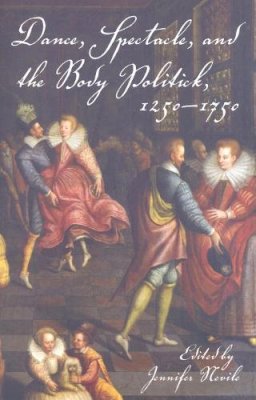
Dance, Spectacle, and the Body Politick, 1250–1750
Nevile
From the mid-13th to the mid-18th century the ability to dance was an important social skill for both men and women. Dance performances were an integral part of court ceremonies and festivals and, in the 17th and 18th centuries, of commercial theatrical productions. Whether at court or in the public theater danced spectacles were multimedia events that required close collaboration among artists, musicians, designers, engineers, and architects as well as choreographers. In order to fully understand these practices, it is necessary to move beyond a consideration of dance alone, and to examine it in its social context. This original collection brings together the work of 12 scholars from the disciplines of dance and music history. Their work presents a picture of dance in society from the late medieval period to the middle of the 18th century and demonstrates how dance practices during this period participated in the intellectual, artistic, and political cultures of their day.
Product Details
About Nevile
Reviews for Dance, Spectacle, and the Body Politick, 1250–1750
Richard Semmens
Early Music America : Mag Historical Perf
Jennifer Nevile's accessibly written anthology seeks to explore many now obscure aspects of early dance: contributions by twelve scholars elucidate the fascinating, multifarious nature of dance from the thirteenth to the eighteenth century. . . . contributors demonstrate a high scholarly standard and pursue their chosen themes with assurance and passion. The great forte of this collection is its ambitious, multidisciplinary range, and the authors' practical insight, honed by years of performance experience, represents a rare feat indeed. The book should be required reading in dance studies.62 Summer 2009
Barbara Ravelhofer
Univeristy of Dunham
A big bite of dance history scholarship is undertaken in this study, and it does not seem to be too big for Jennifer Nevile, the editor of the volume, to chew. . . . Congratulations to . . . Nevile for bringing this impressive collection to life. I have profited considerably from reading the offerings presented here, and I am certain others will, too. I will recommend readings from this volume to my students for years to come. Spring 2009
Richard Semmens
University of Western Ontario, Professor of Music History
Nevile . . . has assembled an intriguing book that in many ways serves as an encyclopedia of early dance—a feat not easily accomplished in one volume. . . . [T]his is a fine resource for those who research this specialized period of dance history. An excellent glossary and bibliography and a 'list of dance treatises, manuscripts, modern editions, and translations' complete the book. Summing Up: Recommended. Graduate students and researchers.March 2009
Choice
This is a great book for understanding music, dance and the part they played in the period covering 1250-1750, in Europe. It is filled with a whole cosmology of ideas. How the arc of five centuries connect, are enmeshed, develop and flow into our own day. This book is a treasure.Winter 2008
Paul-James Dwyer
Toronto Early Music Quarterly
The balanced assortment of general introductions and detailed case studies makes Dance, Spectacle, and the Body Politick, 1250-1750 a useful collection and an engaging 'read' for dance enthusiasts, reconstructors, and scholars alike.
Emily Winerock
Dance Chronicle
[This] collection more than fulfills its goal of opening up pre-1750 dance studies to a general readership, but will also be of interest to the more informed dance historian.
Historical Dance
Dance, Spectacle, and the Body Politick makes an important contribution to existing dance scholarship ... The essays in Nevile's collection add significantly to this diligent work. Every essay is both informative and interesting, and each author provides a valuable list of further readings on the topic.Volume 16 Issue 2 2011
European Legacy
This well-researched and original collection of essays on early dance addresses the picture of dance in society from 1250 to 1750. The interdisciplinary and wide-ranging approach of the book makes it very valuable for dance historians, musicologists and historians of ideas alike, as well as anyone interested in dance history. Issue 78, Autumn 2010
Cahiers Elisabethains
. . . this ambitious anthology . . . manages to fill an academic void . . . .Vol. 35.1 2010
Nicole Haitzinger
University of Salzburg
An important book for any musician, theatrical performer, dancer, historian, reconstructor or anyone involved in recreating the work of this time period. Essays with detailed notes, glossary, bibliography and a list of dance treatises, manuscripts, modern editions and published translations are worth the price of the book alone. A great book for understanding music, dance and the part they played in the period covering 1250-1750, in Europe.Summer 2009
Paul-James Dwyer
Dance International
